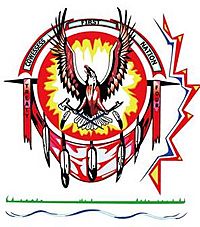Cowessess First Nation facts for kids
 |
|
| People | Saulteaux |
|---|---|
| Treaty | Treaty 4 |
| Headquarters | Cowessess |
| Province | Saskatchewan |
| Land | |
| Main reserve | Cowessess 73 |
| Other reserve(s) | |
| Land area | 421.843 km2 |
| Population (2019) | |
| On reserve | 846 |
| Off reserve | 3449 |
| Total population | 4295 |
| Government | |
| Chief | Cadmus Delorme |
| Website | |
| cowessessfn.com | |
The Cowessess First Nation is a First Nation community located in southern Saskatchewan, Canada. They are part of the Saulteaux people. Their main home is the Cowessess 73 reserve. This reserve is found in the beautiful Qu'Appelle Valley. The Cowessess First Nation also manages another area called Cowessess 73A near Esterhazy. They also share Treaty Four Reserve Grounds 77 with 32 other First Nations.
Contents
About Cowessess First Nation
The Cowessess First Nation is named after their important leader, Chief Cowessess. His name means "Little Boy" or "Little Child." His group was made up of different peoples, including Plains Cree, Saulteaux, and Métis. Long ago, they were nomadic, meaning they moved around a lot. They hunted bison across a wide area, from Saskatchewan all the way to Montana.
A Look at Their History
In September 1874, Chief Cowessess signed Treaty 4 at Fort Qu'Appelle. This agreement was about sharing the land with the British Crown. Even after signing the treaty, the group continued to travel for a few more years. Around 1878-1879, they started farming near Maple Creek.
In 1880, a special area was set aside for them as a reserve. This was at Crooked Lake in the Qu'Appelle Valley. Chief Cowessess stayed in the Cypress Hills until 1883. But another leader, Louis O'Soup, brought a group to settle on the new reserve. The community was first called "Crooked Lake Mission." Later, in 1908, it became known as "Marieval" when a post office was opened there.
The Marieval School
In 1880, a log schoolhouse was built in the community. Then, in 1898, a residential school opened. It was run by the Sisters of St. Joseph. The parents of the Cowessess reserve wanted a different kind of school. They asked for a day school that was not run by a church as early as 1949, but their requests were not accepted.
The Canadian government took control of the school building in 1968. Later, in 1981, the First Nation itself took over running the school. The Marieval school closed its doors in 1997. The building was taken down in 1999. This school was part of a larger system of residential schools in Canada. These schools had a lasting impact on Indigenous communities.
Protecting Their Land
Soon after the reserve was created, some settlers nearby wanted to buy parts of the land. They asked for the southern part of the reserve to be sold. In the 1890s, these requests were turned down. The Indian agent was worried about the First Nation's ability to support themselves.
Later, in 1907, a vote was held about giving up some land. The vote was very close. As a result, nearly 75% of the First Nation's open farmland was lost. This made it harder for the community to support itself.
In 1981, the Cowessess First Nation started a special claim with the government. They argued that the way the land was given up was not fair. They have since been part of a process called Treaty Land Entitlement. This process helps First Nations expand their reserve lands. It allows them to buy back land from willing sellers. This helps the Cowessess First Nation get back some of the land they lost.

